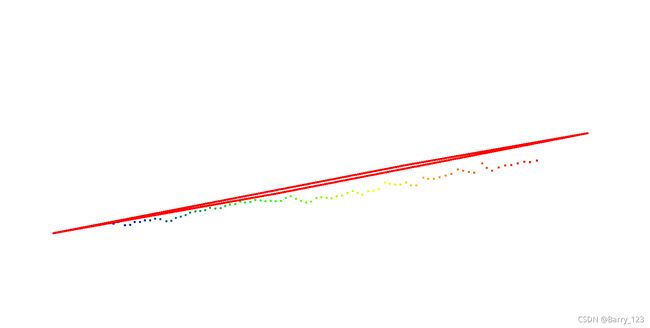Lidar-camera calibration单线激光雷达与相机外参标定
课题中涉及多传感器融合定位的部分,需要对camera、IMU、2d-Lidar进行外参标定。camera-IMU标定可以使用Kalibr,但是单线激光雷达和相机的的标定目前能找到的只有贺老师开源的这个工具了
参考1:CamLaserCalibraTool
参考2:实践之Camera-Lidar标定
参考3:CSDN博客
如参考博客中博主所说,使用作者给的测试数据可以得到比较好的标定结果,但是自己录制的数据标注时就会有一些问题。
我自己的数据一开始测试效果也不太理想,研究了一段时间代码后发现有几个问题对标定结果影响比较大,调整策略后得到了比较理想的标定结果,和大家分享一下:
1、作者重点说明了标定板需要对俯仰和滚转两个自由度充分激励以产生足够多的有效观测,而实际上把标定板前后运动也很重要,这个可以参考作者给的测试bag包;
2、原代码中的外参初始值求解有时候不太稳定,可以尝试自己计算一个大概的外参作为初始值再进行优化;
3、代码calibr_offline.cpp中有两个地方可以尝试修改:
①CamLaserCalibration这个函数,可以将参数设置成利用标定板边界的约束(默认是使用所有的激光点);
②有一段选择关键图像帧的代码可以尝试将其注释掉。
/// Select keyframe to calibrating
std::vector<CamPose> sparseTagpose;
CamPose older = tagpose.at(0);
sparseTagpose.push_back(older);
double dist_min = 0.20; // 10cm
double theta_min = 3.1415926 * 10 / 180.;
for (int j = 1; j < tagpose.size(); ++j)
{
CamPose newer = tagpose.at(j);
double dist = (older.twc - newer.twc).norm();
double theta = 2 * std::acos(((older.qwc.inverse() * newer.qwc)).w());
if ((dist > dist_min) || (fabs(theta) > theta_min))
{
older = newer;
sparseTagpose.push_back(older);
}
}
tagpose = sparseTagpose;
这段代码本意是希望可以降低计算量,因为两帧图像之间的位姿变化太小的话其提供的观测约束基本是一样的,数据意义不大,所以可以忽略。但是这样可能会造成之后根据激光雷达数据寻找时间戳间隔最近的图像时找不到合适的图像,因此对结果会有一些影响。我自己的数据中去除这段代码后效果有比较大的提升。
另外我感觉直接将激光雷达数据投影到图像中的方式不是特别直观,因此将指定时间戳附件的一帧激光雷达点云和对应的棋盘格平面输出出来,放到cloudcompare中去做可视化(将激光雷达点云通过标定得到的变换矩阵的逆变换将其转到相机坐标系下,即可直观看出激光雷达点云与棋盘格平面的位置关系)。


附上我改过之后的calibr_offline.cpp
#include sparseTagpose;
// CamPose older = tagpose.at(0);
// sparseTagpose.push_back(older);
// double dist_min = 0.20; // 10cm
// double theta_min = 3.1415926 * 10 / 180.;
// for (int j = 1; j < tagpose.size(); ++j)
// {
// CamPose newer = tagpose.at(j);
// double dist = (older.twc - newer.twc).norm();
// double theta = 2 * std::acos(((older.qwc.inverse() * newer.qwc)).w());
// if ((dist > dist_min) || (fabs(theta) > theta_min))
// {
// older = newer;
// sparseTagpose.push_back(older);
// }
// }
// tagpose = sparseTagpose;
// 准备标定数据
std::vector<Oberserve> obs;
// 处理激光数据
int ii_cnt = 10;
for (rosbag::MessageInstance const m : views)
{
if (m.getTopic() == scan_topic_name)
{
sensor_msgs::LaserScan::Ptr scan = m.instantiate<sensor_msgs::LaserScan>();
std::vector<Eigen::Vector3d> Points;
TranScanToPoints(*scan, Points);
// ii_cnt++;
// if(ii_cnt % 20 != 0) continue;
double timestamp = scan->header.stamp.toSec();
// save the "timestamp_tosave" frame of scan
if (fabs(timestamp_tosave - timestamp) <= 0.01)
{
outputfile_scan.open("/home/lyd/output/lv_calibr/pointcloud_scan.txt");
std::cout<<"find the frame: "<<std::fixed<<std::setprecision(10)<<timestamp<<std::endl;
for (size_t i = 0; i < Points.size(); ++i)
{
outputfile_scan << i << " " << Points[i][0] << " " << Points[i][1] << " " << Points[i][2] << std::endl;
}
outputfile_scan.close();
}
std::vector<Eigen::Vector3d> points;
points = AutoGetLinePts(Points);
// 检测到了直线
if (points.size() > 0)
{
// 在 camera 里找时间戳最近的一个 pose
double min_dt = 10000;
CamPose colsetTagPose;
for (int i = 0; i < tagpose.size(); ++i)
{
CamPose tmp = tagpose.at(i);
double t = fabs(tmp.timestamp - timestamp);
if (t < min_dt)
{
min_dt = t;
colsetTagPose = tmp;
}
}
if (fabs(timestamp_tosave - colsetTagPose.timestamp) <= 0.05)
{
outputfile_tag.open("/home/lyd/output/lv_calibr/pointcloud_tag.poly");
std::cout<<std::fixed<<std::setprecision(10)<<"find the frame pose: "<<colsetTagPose.timestamp<<std::endl;
//outputfile_tag<
Eigen::Vector3d orig(0.0265+0.0165,0.0265+0.0165,0);
Eigen::Vector3d p1m( 0, 0, 0);
Eigen::Vector3d p2m( 0.5, 0, 0);
Eigen::Vector3d p3m( 0., 0.5, 0);
Eigen::Vector3d p4m( 0.5, 0.5, 0);
p1m -= orig;
p2m -= orig;
p3m -= orig;
p4m -= orig;
// 旋转到相机坐标系
Eigen::Vector3d p1c = colsetTagPose.qwc.toRotationMatrix().inverse() * (p1m - colsetTagPose.twc);
Eigen::Vector3d p2c = colsetTagPose.qwc.toRotationMatrix().inverse() * (p2m - colsetTagPose.twc);
Eigen::Vector3d p3c = colsetTagPose.qwc.toRotationMatrix().inverse() * (p3m - colsetTagPose.twc);
Eigen::Vector3d p4c = colsetTagPose.qwc.toRotationMatrix().inverse() * (p4m - colsetTagPose.twc);
outputfile_tag<<p1c[0]<<" "<<p1c[1]<<" "<<p1c[2]<<std::endl;
outputfile_tag<<p2c[0]<<" "<<p2c[1]<<" "<<p2c[2]<<std::endl;
outputfile_tag<<p4c[0]<<" "<<p4c[1]<<" "<<p4c[2]<<std::endl;
outputfile_tag<<p3c[0]<<" "<<p3c[1]<<" "<<p3c[2]<<std::endl;
outputfile_tag<<p1c[0]<<" "<<p1c[1]<<" "<<p1c[2]<<std::endl;
// outputfile_tag<
// outputfile_tag<
// outputfile_tag<
// outputfile_tag<
outputfile_tag.close();
}
if (min_dt < 0.02) // 20ms
{
// std::cout << "scan and tag time: "<
// <
/
Eigen::Vector2d line;
LineFittingCeres(points, line);
std::vector<Eigen::Vector3d> points_on_line;
// 激光所在直线不能垂直于某个轴
double x_start(points.begin()->x()), x_end(points.end()->x());
double y_start(points.begin()->y()), y_end(points.end()->y());
if (fabs(x_end - x_start) > fabs(y_end - y_start))
{
y_start = -(x_start * line(0) + 1) / line(1);
y_end = -(x_end * line(0) + 1) / line(1);
}
else // 可能垂直于 x 轴,采用y值来计算 x
{
x_start = -(y_start * line(1) + 1) / line(0);
x_end = -(y_end * line(1) + 1) / line(0);
}
points_on_line.push_back(Eigen::Vector3d(x_start, y_start, 0));
points_on_line.push_back(Eigen::Vector3d(x_end, y_end, 0));
Oberserve ob;
ob.tagPose_Qca = colsetTagPose.qwc.inverse();
ob.tagPose_tca = -ob.tagPose_Qca.toRotationMatrix() * colsetTagPose.twc;
ob.points = points;
ob.points_on_line = points_on_line;
obs.push_back(ob);
}
}
}
}
if (obs.size() < 5)
{
std::cout << "Valid Calibra Data Less" << std::endl;
bag_input.close();
return 0;
}
std::cout << "obs size: " << obs.size() << std::endl;
// Eigen::Matrix4d Tlc_initial = Eigen::Matrix4d::Identity();
// CamLaserCalClosedSolution(obs,Tlc_initial);
// hand computation for initialization --liyida 2021.10.27
Eigen::Matrix4d Tlc_initial;
Tlc_initial <<
// -1.3124710880100743e-01, 9.3463583566847663e-01, 3.3049969911584742e-01, -5.5852932629091622e-03,
// -1.5956766335713890e-01, 3.0911958766939568e-01, -9.3754106114337521e-01, -1.2906010084882734e-02,
// -9.7842340387079885e-01, -1.7578661838544923e-01, 1.0856660423209767e-01, 7.1673734951464345e-02,
// 0., 0., 0., 1.;
// best parameters
-2.0534250949794348e-02, 9.3632715066297922e-01,3.5052790398094774e-01, -6.2470572003489024e-02,
-1.6987064830015094e-01, 3.4223670240822079e-01,-9.2413094438549825e-01, -2.9679393942842452e-02,
-9.8525240795646707e-01, -7.8520739019019389e-02,1.5202692577267340e-01, -10.1246090843195932e-02,
0., 0., 0., 1.;
theoretical parameters
// 0., 0.9396,0.342020, -0.06,
// 0., 0.342020,-0.9396, -0.5,
// -1.0, 0.,0., -0.07,
// 0., 0., 0., 1. ;
Eigen::Matrix4d Tcl = Tlc_initial.inverse();
CamLaserCalibration(obs, Tcl, false, true);
// CamLaserCalibration(obs,Tcl, true);
std::cout << "\n----- Transform from Camera to Laser Tlc is: -----\n"
<< std::endl;
Eigen::Matrix4d Tlc = Tcl.inverse();
std::cout << Tlc << std::endl;
std::cout << "\n----- Transform from Camera to Laser, euler angles and translations are: -----\n"
<< std::endl;
Eigen::Matrix3d Rlc(Tlc.block(0, 0, 3, 3));
Eigen::Vector3d tlc(Tlc.block(0, 3, 3, 1));
EulerAngles rpy = ToEulerAngles(Eigen::Quaterniond(Rlc));
std::cout << " roll(rad): " << rpy.roll << " pitch(rad): " << rpy.pitch << " yaw(rad): " << rpy.yaw << "\n"
<< "or roll(deg): " << rpy.roll * 180. / M_PI << " pitch(deg): " << rpy.pitch * 180. / M_PI << " yaw(deg): " << rpy.yaw * 180. / M_PI << "\n"
<< " tx(m): " << tlc.x() << " ty(m): " << tlc.y() << " tz(m): " << tlc.z() << std::endl;
// save to yaml file
cv::Mat cvTlc;
cv::eigen2cv(Tlc, cvTlc);
std::string fn = savePath + "result.yaml";
cv::FileStorage fs(fn, cv::FileStorage::WRITE);
fs << "extrinsicTlc" << cvTlc;
cv::Mat cvrpy;
cv::eigen2cv(Eigen::Vector3d(rpy.roll, rpy.pitch, rpy.yaw), cvrpy);
cv::Mat cvtlc;
cv::eigen2cv(tlc, cvtlc);
fs << "RollPitchYaw" << cvrpy;
fs << "txtytz" << cvtlc;
fs.release();
std::cout << "\n Result file : " << fn << std::endl;
std::cout << "\n-------------- Calibration Code End --------------\n"
<< std::endl;
ros::spin();
outputfile_tag.close();
}
需要注意的是如果需要输出激光雷达点云进行可视化的话,需要改一下utilties.cpp这个文件中的TranScanToPoints函数,这个函数将sensor_msgs::LaserScan数据转成std::vectorEigen::Vector3d格式,其中将超出量程的点(噪声)设置成了Eigen::Vector3d(1000.0,1000.0, 0),这样后面可视化的时候会出现尺度偏得离谱。所以我将超出量程的点设置成了Eigen::Vector3d(0,0, 0),当然也可以选择直接将其忽略。,下面是我的修改:
for (size_t i = 0; i < n_pts; ++i) {
// TODO: range_cutoff threashold
double range_cutoff = 30.0;
const float range = scan_in.ranges[i];
if (range < range_cutoff && range >= scan_in.range_min)
{
Points.push_back(Eigen::Vector3d(output (i, 0), output (i, 1), 0) );
} else
{
Points.push_back(Eigen::Vector3d(0,0, 0) );
//Points.push_back(Eigen::Vector3d(1000.0,1000.0, 0) );
}
}
